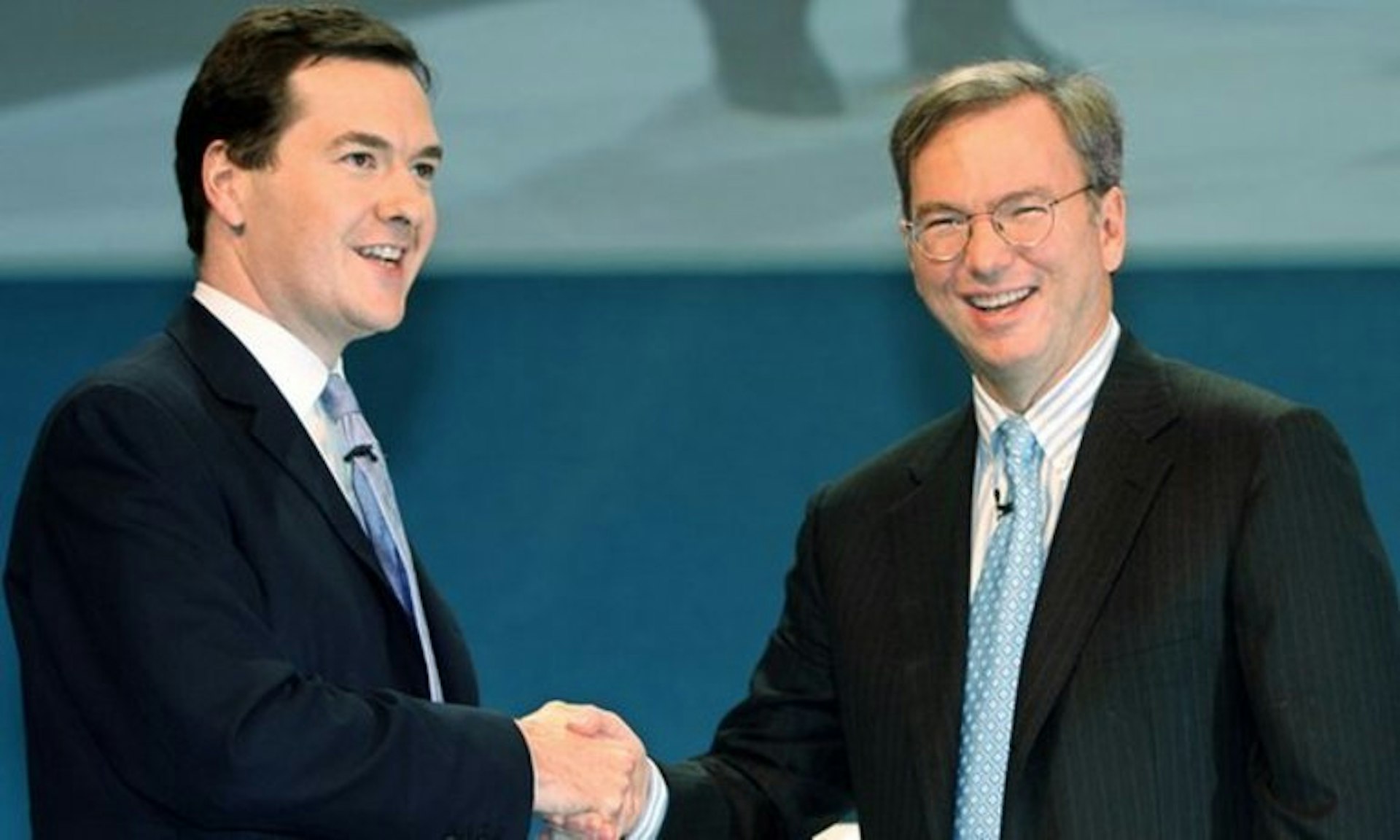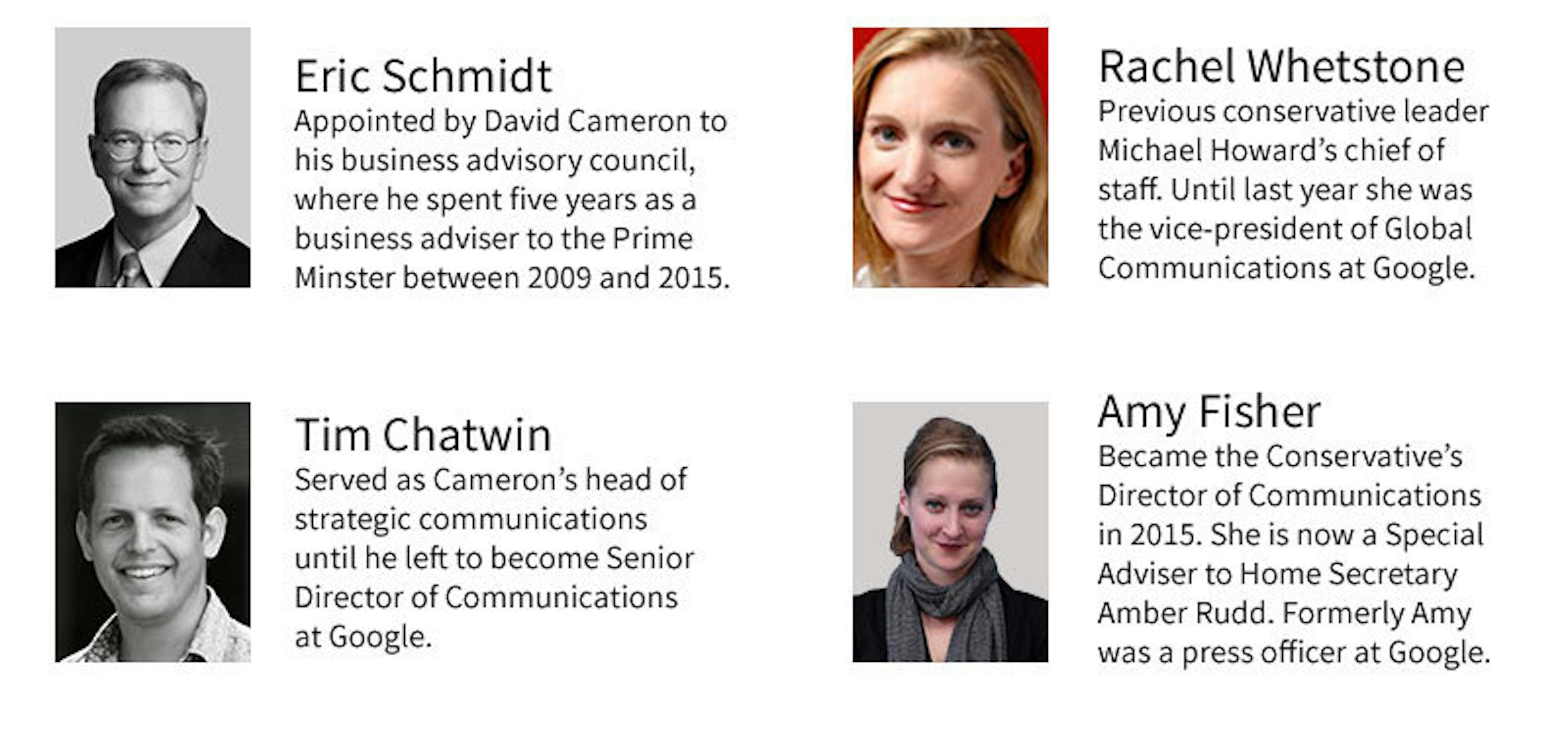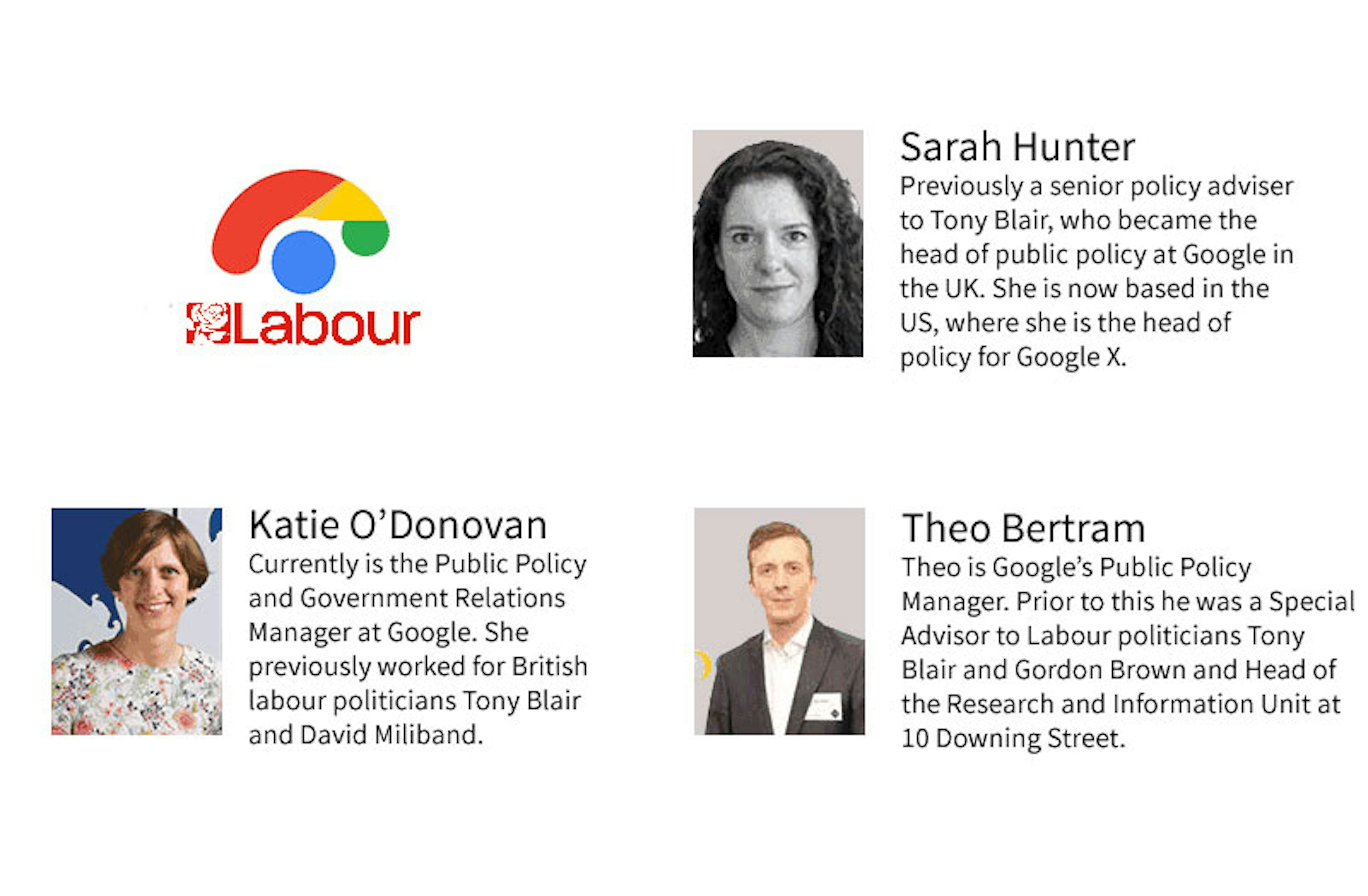The following post and data analysis was created by the Berlin-based Tactical Technology Collective partly using data compiled by the Google Transparency Project. The post is reproduced with its kind permission.
Google portrays a fun, friendly, informal image that effectively distracts from the company's ever-increasing accumulation of wealth, information and influence.
We decided to look beyond the primary colours to something darker and investigate one specific aspect of this activity: the revolving door between Google and public institutions (specifically, European institutions).
We were able to find a surprising amount of information online, from publicly-available sources - the trick often just lay in knowing where to look.
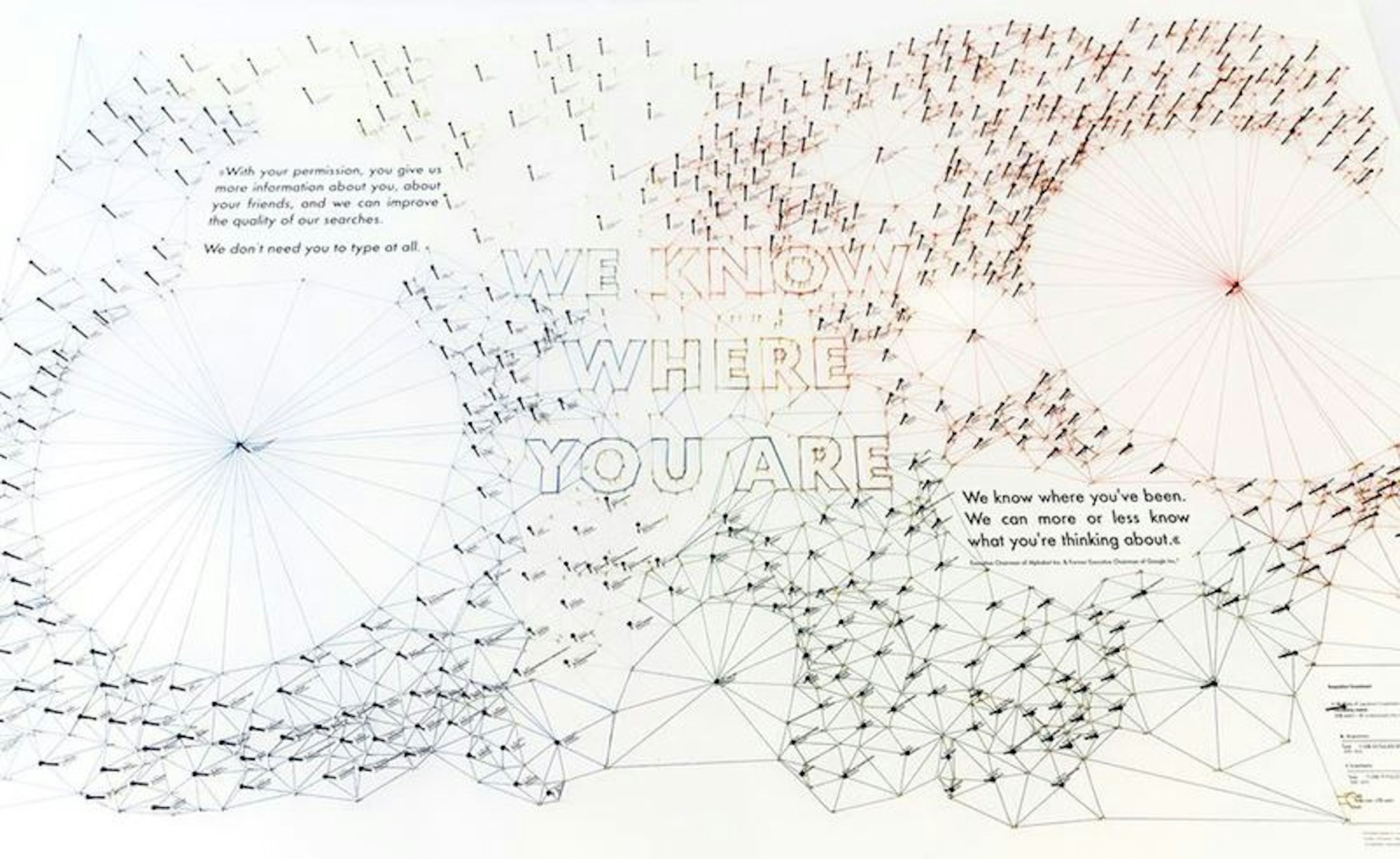
The Alphabet Empire by Tactical Tech and La Loma as shown in The Glass Room in New York. Based on openly available information, this 3-D infographic combines a quote from its chairman, Eric Schmidt, with a mapping of its acquisitions and investments.
By Google's own admission, the company, like many others, cultivates close relationships with governmental bodies and public officials. Google disclosed that in 2015 it spent over €4 million on lobbying the European Union - considerably more than the €1 million on lobbying spent just three years previously in 2012.
But some of Google's relationships with public bodies and officials come with a smaller price tag: Over the past ten years at least 80 people have been identified to have moved jobs between Google and European governments.
It's this "revolving door" that formed the basis of our investigation. We started out with a number of questions: who were these people who had moved from Google to government or vice versa? Where exactly did they move from and to, and when? And most importantly how many of these questions could we find answers to using open, publicly-available information?
Here's what we learned, and how we did it.
Querying Google's revolving door
The Google Transparency Project records movements of people between governmental organisations and Google, the so-called 'revolving door', thereby tracking people's employment transitions, both from governments to Google and vice versa. In June 2016 the initiative had identified at least 80 individuals who moved jobs between Google and European governments over the past ten years. This is, of course, not just a European occurrence and the Google Transparency Project has also released data on the revolving door moves taking place in the US.
Following the release of this dataset we spent a week at the Digital Methods Summer School at the University of Amsterdam. Here we used the dataset released by the Google Transparency Project as a jumping off point to expand the evidence collected. We combined this dataset with information gathered from networking platforms such as LinkedIn and Twitter, along with search engine search requests and data collected from online news sites.
Transparency International defines the revolving door as the "movement of individuals between positions of public office and jobs in the same sector in the private or voluntary sector, in either direction. If not properly regulated, it can be open to abuse."
This abuse largely refers to conflicts of interest. As described by the Google Transparency Project; "Google has been among the most vocal advocates for transparency and openness in government, corporate America [and Europe] and society at large, but does not subject itself to the same level of transparency. For all its calls for others to open up, the company is highly opaque about its own operations and dealings with government. From its relationships with elected and appointed officials to its lobbying and public policy operations, Americans [and Europeans] know surprisingly little about how Google gets what it wants from their government."
Before we began looking at the dataset from the Google Transparency Project we wanted to find information on the amount of money Google was spending on lobbying the European Union.
Through searching for information on Google on the open data portal Lobbyfacts.eu, a website that compiles information from the EU Transparency Register, we found that the money Google spends currently on lobbying has increased dramatically year on year. The graphic below illustrates the amount of money Google reports to spend on lobbying (over €4 million in 2015).
Since 2011 there has been a voluntary lobbyist registration which lists organisations and individuals who intend to influence European lawmaking. In the Google Transparency Project's dataset, out of the nine registered Google lobbyists, seven were identified and are included in the dataset.
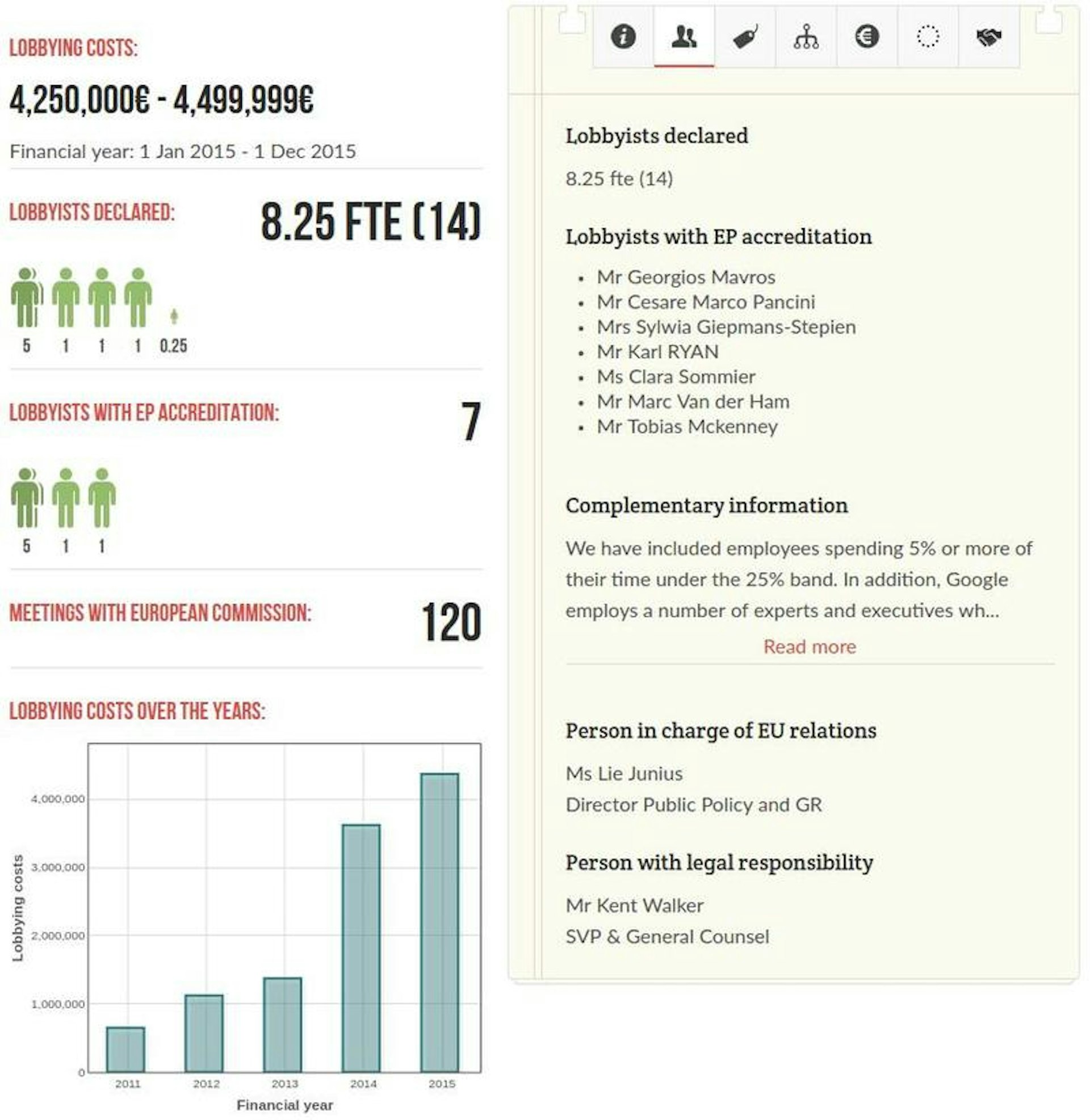
Screenshot taken from the Google data card on Lobbyfacts.eu on 28 November 2016
Querying the data
Our first stage was to analyse and visualise the data we had from the Google Transparency Project and online media sources to assess what complimentary data we wanted to find and where we could look for it.
The data we had from the Google Transparency Project (see the dataset here) featured names of people who had moved from Google to government positions or vice versa, which organisation they had left or joined, the leaving and joining dates, their old and new titles and where this information was gleaned from. The data sources for the Google Transparency Project were online news articles and individual LinkedIn pages.
From this dataset we focused on asking three questions: which countries these individuals are moving to Google from, who are the people moving; and when they moved.
Our plan was then to look at additional data sources to test out some assumptions we held that those leaving governmental positions were being hired by Google for their connections and influence within government bodies. To try to understand this we searched for additional information online concerning skills and expertise, job roles and social ties that were moving between Google and governments.
For our research we primarily focused on the Google Transparency Project's European dataset rather than the US dataset. This was based on the group's geographical make up, the size of the dataset being more manageable and that the European context has so far been less investigated in comparison to the U.S.
Googlexit: Who is moving to join Google?
The individuals leaving Google most often work for the European Commission and the European Parliament as well as UK government institutions. We found very few cases of individuals who worked for both Google and European governmental institutions at the same time and these few cases were usually individuals advising governmental bodies on a particular issue for a limited time.
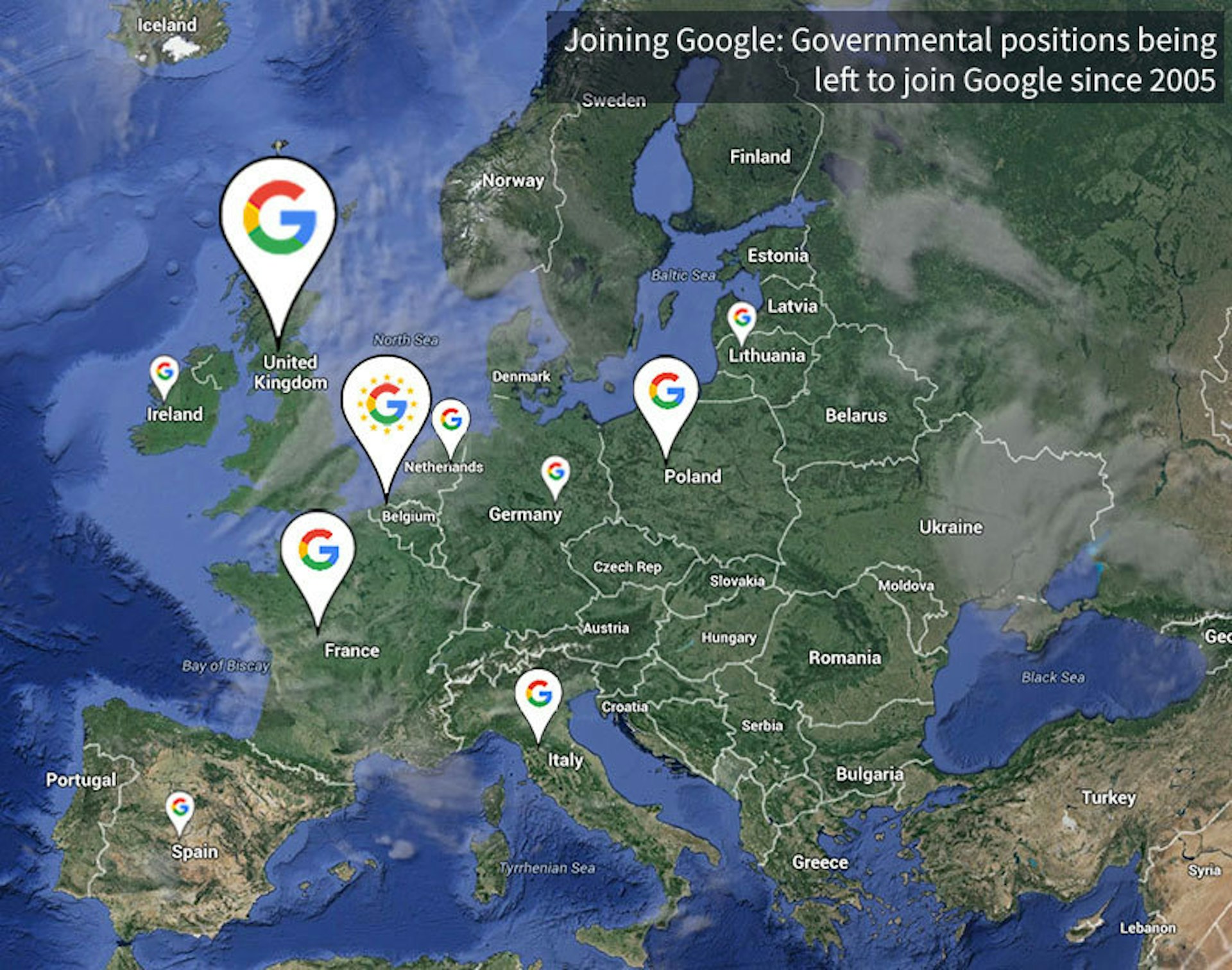
Google migration flows. Data research by the working group during the University of Amsterdam Digital Methods workshop. Visualisation by Exposing the Invisible.
The UK: A two-party system
We wanted to have a closer look at the UK as it contained the highest number of people per country joining Google. A question we had was, did this revolving door occur most during the Conservative government of David Cameron or the Labour government of Tony Blair or was there no difference between the two?
Through trawling through newspaper articles and Google searches there were a number of connections between David Cameron and those who have a specific tie with both him and Google. We found that this is not just a Conservative party phenomenon as Tony Blair had his own networks and ties.
The headquarters of the UK government, 10 Downing Street, has seen the most individuals leaving for Google in comparison to any other UK government institutions observed in the dataset. Here are some examples of these high profile hires between Google and the Conservative and Labour party.
When are they moving?
Now that we understood more about where people were leaving from and moving to we wanted to explore when they were moving. By plotting this we hoped that we could spot trends that were happening over time.
Through the dataset we had temporal information on when people were moving and joining various government organisations and bodies and also joining Google. We created a timeline of these events that maps individual employment moves of government officials and Google employees.
Interestingly, a few individuals left their government jobs to work for Google in 2011. We were facing time-constraints so could not fully explore the factors that drove this shift but are curious to know what may have triggered this move?
We suspect that, in terms of the UK, this could have followed the 2010 general election where Google employees were hired to join the Prime Minister David Cameron's team, however in this respect we didn't see many moves in 2014 or 2015 which was also an election year for the UK, European Parliament, France and Belgium.
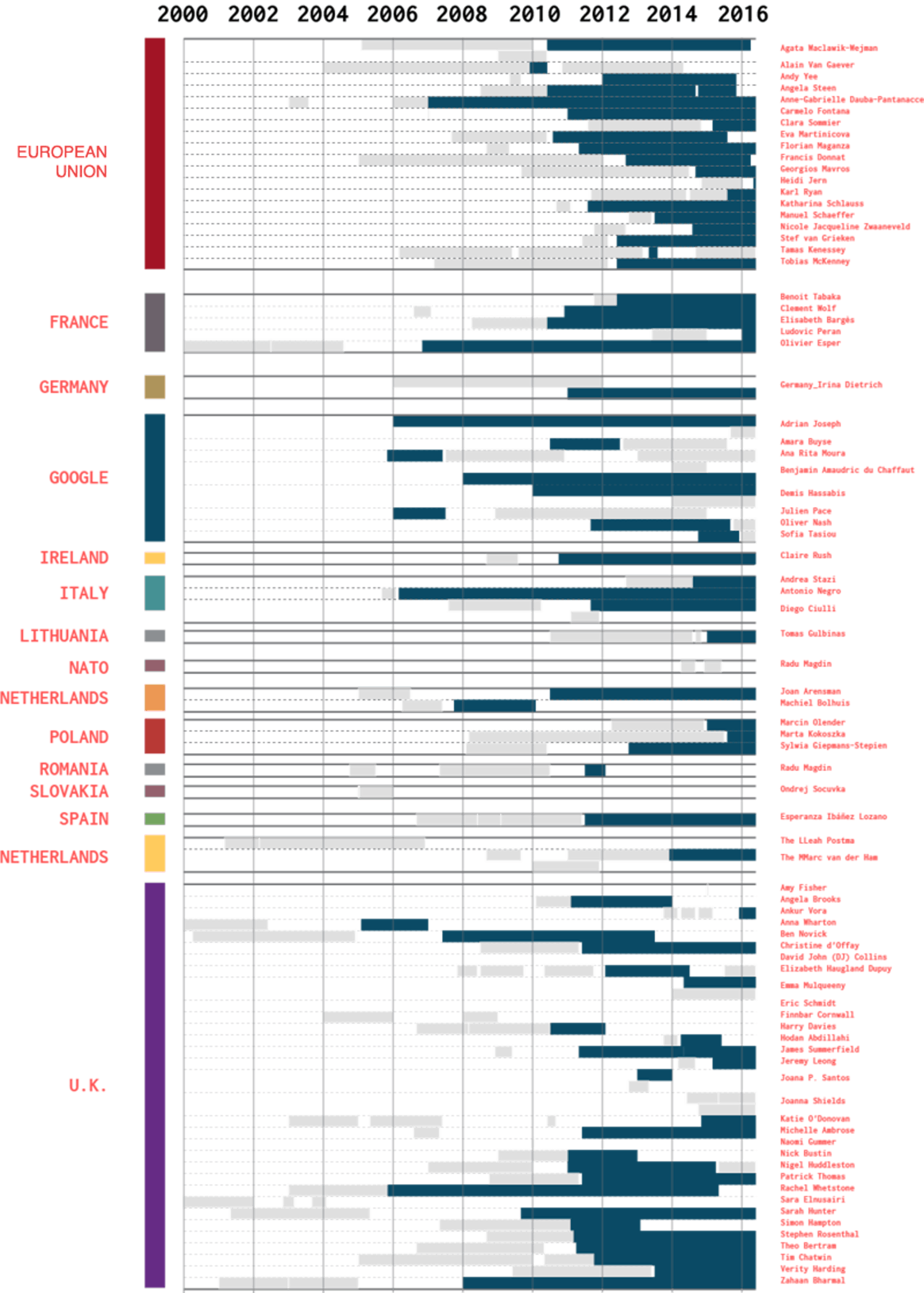
The darker blue signifies when the individual moved to their current role. Time perspective on individuals moving from government institutions to Google and vice versa. Visualisation and research by the working group during the University of Amsterdam Digital Methods workshop.
Finding data from Twitter and LinkedIn
After we had analysed and visualised the Google Transparency Project's dataset we wanted to dig a little deeper and find more information and to test out some assumptions we held that those leaving governmental positions were being hired by Google for their connections and influence within government bodies.
To try to understand this we searched for additional information online concerning skills and expertise, job roles and social ties that were moving between Google and governments. We looked for this information on two networking platforms; Twitter and LinkedIn.
We had the names of the individuals so manually searched for any Twitter profiles they had and also had a closer look at the LinkedIn pages of the individuals that the Google Transparency Project had already taken information from.
LinkedInvestigation: A lobbyists profile prediction algorithm?
As the Google Transparency Project had already scraped information from LinkedIn we focused on data not included in the dataset, for example, the universities that the people on the list attended and the top skills and expertise they had added to their LinkedIn profiles. Gathering information from LinkedIn proved difficult as it required a certain amount of consent to access the information. The LinkedIn data we did scrape proved to be of relatively good quality as it largely coincided with official EU databases on lobbyists.
We were able to build on this quality by focusing on the UK, as LinkedIn tends to be more widely used in the Anglo-American context. Xing is often used, for instance, in German-speaking countries. In addition, people working in technology companies tend to be well-represented on platforms such as LinkedIn.
In our dataset we did find some people that could be verified as influential through qualitative research on newspaper articles. However, many of them were not as active on networking platforms as one might expect in light of their positions and we found many of the higher-tier employees difficult to track down.
Watercooler connections
We wanted to plot the organisations that the individuals had either previously worked for or were currently working for. We hoped this would offer some insight as to whether those moving through the revolving door knew each other through previous workplaces and also whether those using the revolving door were over represented in particular institutions or companies.
Through plotting this data we could clearly see the British dominance in the resulting visualisation. The Labour Party, Conservative Party, 10 Downing Street and House of Commons are clearly key shared workplaces. The two most common places for a Google employee included in this dataset to have worked is in European Parliament or at the European Commission. Other companies mentioned in the list of shared workplaces are companies Uber and Cisco Systems.
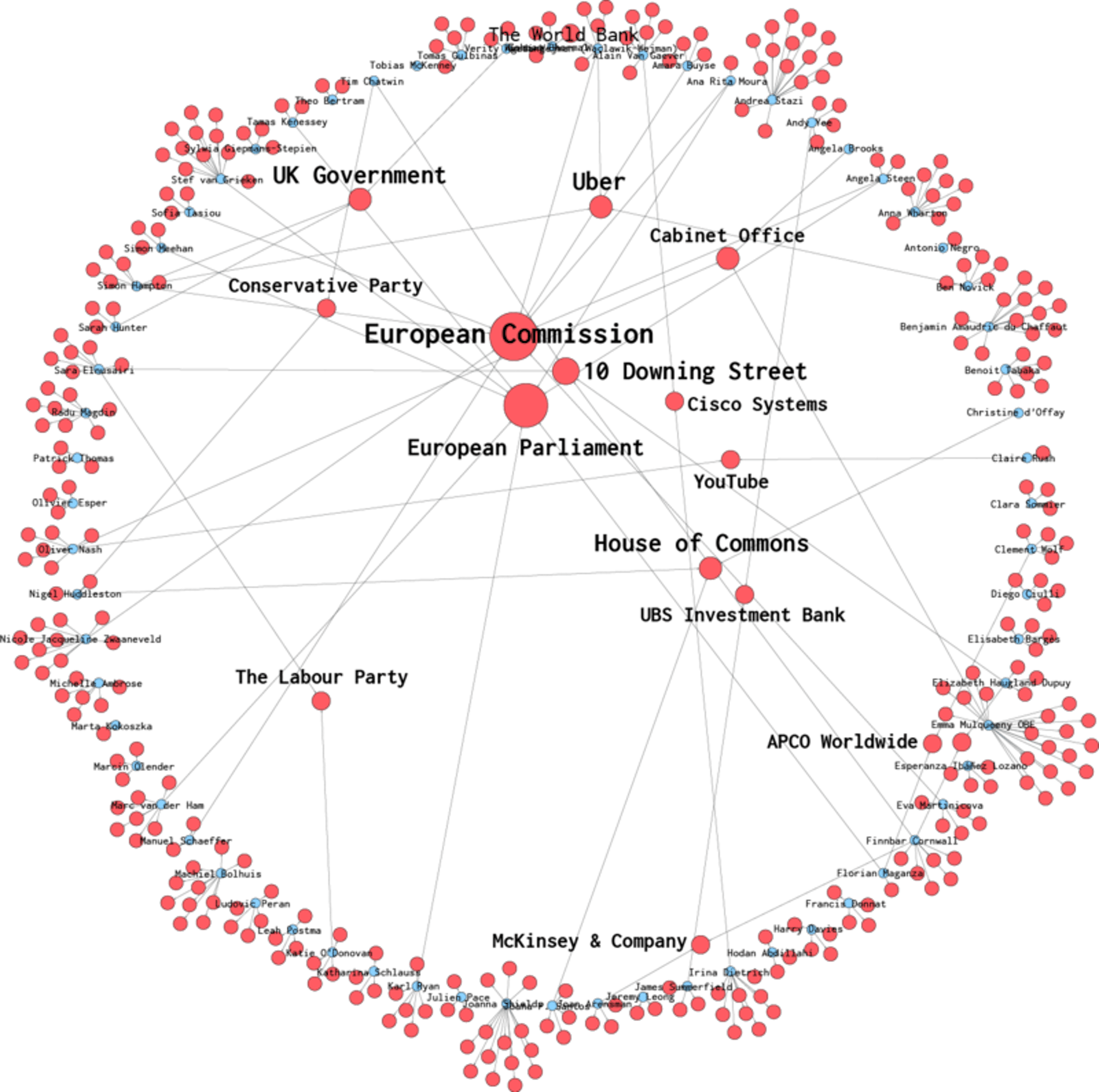
Workplaces are represented in red, people are represented by blue circles. Visualisation and research by the working group during the University of Amsterdam Digital Methods workshop.
Skills flow
As we were looking through the LinkedIn profiles many of them identified key skills and expertise that they believed they possessed and were marketing on their profile.
This level of detail on the type of people moving between these organisations was interesting to us to try to map and analyse, to see if there were any common skills that people shared. We were also interested to investigate whether Google was actively employing a specific type of employee coming from governmental institutions who contained particular skills and expertise.
Through scraping the skills and expertise listed on these LinkedIn profiles we found a few interesting insights.
The skill that was mentioned most frequently of those leaving Google was listed as Strategic Communications, and for those joining Google the top three skills they gained were Public Policy, Politics and Strategy.
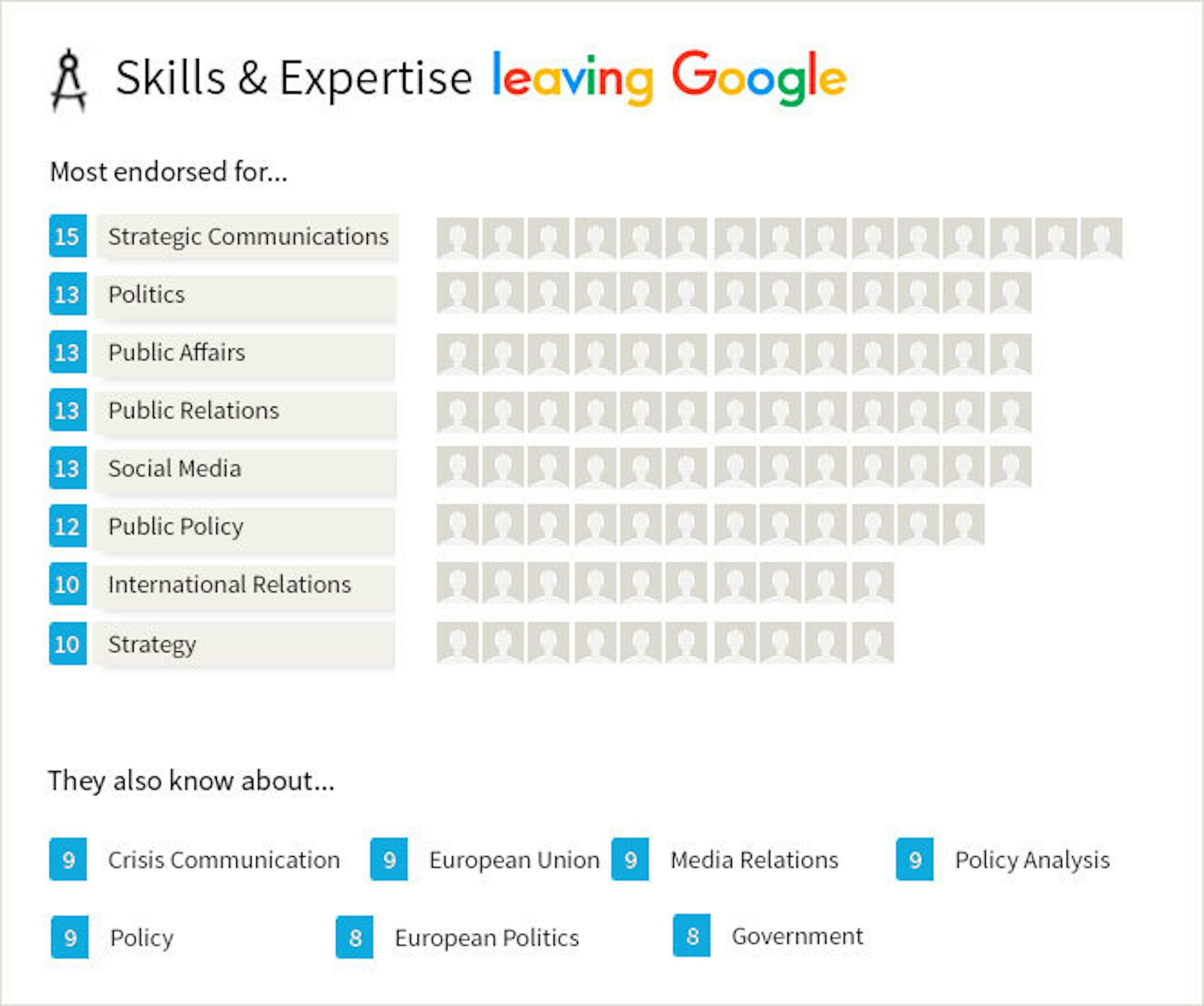
Visualisation by Exposing the Invisible, research by the working group during the University of Amsterdam Digital Methods workshop.
For those joining Google, Google can expect to gain more specific knowledge of International Relations, the European Union and, further down the list, International Law and European Law.
This was interesting to see as it helps shed some light on the type of employees Google might be interested in hiring from European institutions and provides some insight into what the company might want to utilise these new employees to work on.
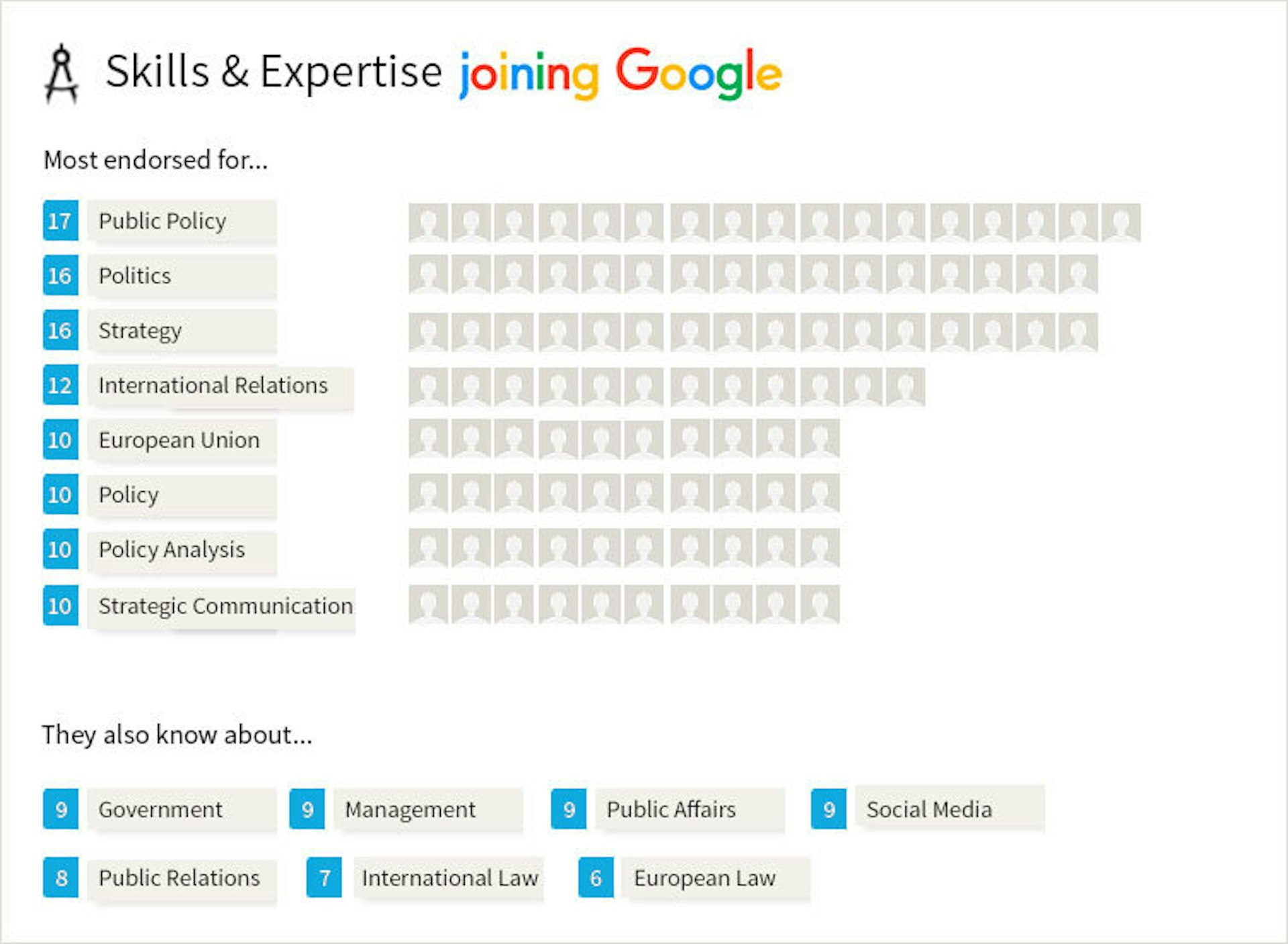
Visualisation by Exposing the Invisible, research by the working group during the University of Amsterdam Digital Methods workshop.
We also looked at universities that those located on LinkedIn had attended to see if there were many overlaps of those attending similar universities or universities that came up frequently. We attempted to look into affiliations with universities as a proxy for real-world ties.
The results did not lead to an interesting conclusion, apart unsurprisingly, that the University of Oxford in the UK was the most frequently attended university by the individuals in the dataset. The conclusion we reached was that when investigating this dataset in a European context rather then an US one, where Ivy League schools dominant the employee pool, European university attendance was a less interesting indicator of influence.
The individuals in our dataset share not only a past or current employer, Google, but potentially also interests and perhaps even follow and interact with one another on social media. The dataset from the Google Transparency Project did not contain information gathered from Twitter in their results. During this week we wanted to see if we could track offline ties through gathering information on online connections.
Through using our data scraping tool Littlespoon (the code for the tool is online here, watch this space for the next release of the tool with a usable interface coming soon) we looked at different ways Twitter profiles are connected to one another through indicators such as:
- Who is following who
- Interesting information contained in their short bios
- Interactions in the form of mentions and replies
- Hashtags in order to see which profiles are talking about the same topics and using the same hashtags, which often feels like a coordinated effort.
When comparing the datasets for the US and Europe we were able to identify a larger number of Twitter handles in the European dataset. Of the publicly available accounts, hashtags and mentions were collected as well as who the people on our list were following and who follows them.
We found that those with real power and influence are difficult to track online through Twitter and LinkedIn and gathering information on their online profiles proved limited when compared to those more transient members of Google and government institutions.
What are people involved in revolving door moves talking about?
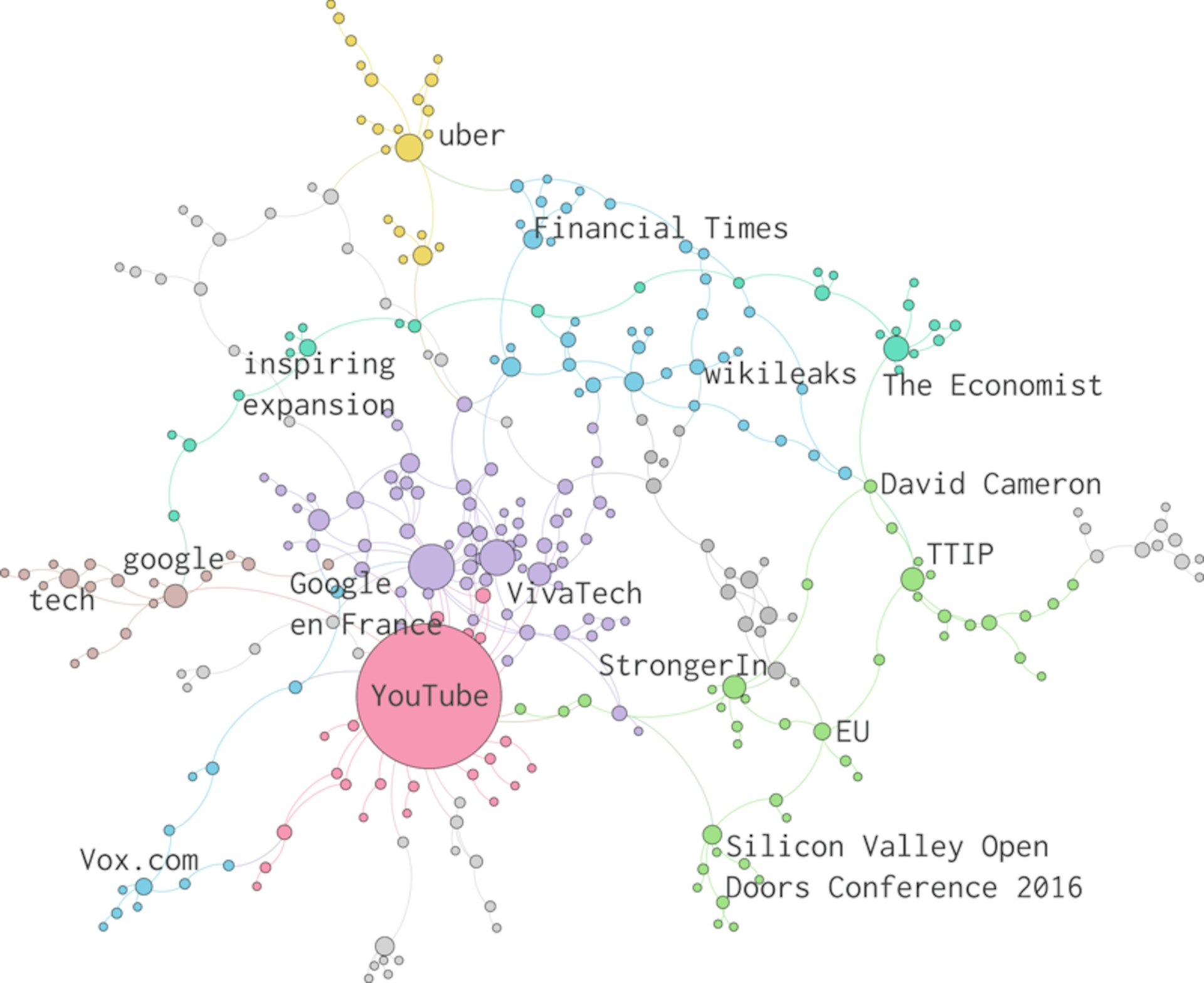
First we wanted to understand what people in our dataset were talking about on Twitter. We gathered 5076 tweets (this roughly equates to 200 tweets gathered per person) and through inputing these tweets, and their associated hashtags, into the visualisation software, Gephy, we could see a number of key terms being mentioned. It seems from the data we collected that the Twitter users in our dataset are sharing information on one of Google's products YouTube, the Transatlantic Trade and Investment Partnership (TTIP), the Brexit remainers hashtag #StrongerIn and Uber, to name a few of the more frequently used hashtags.
Who do they listen to?
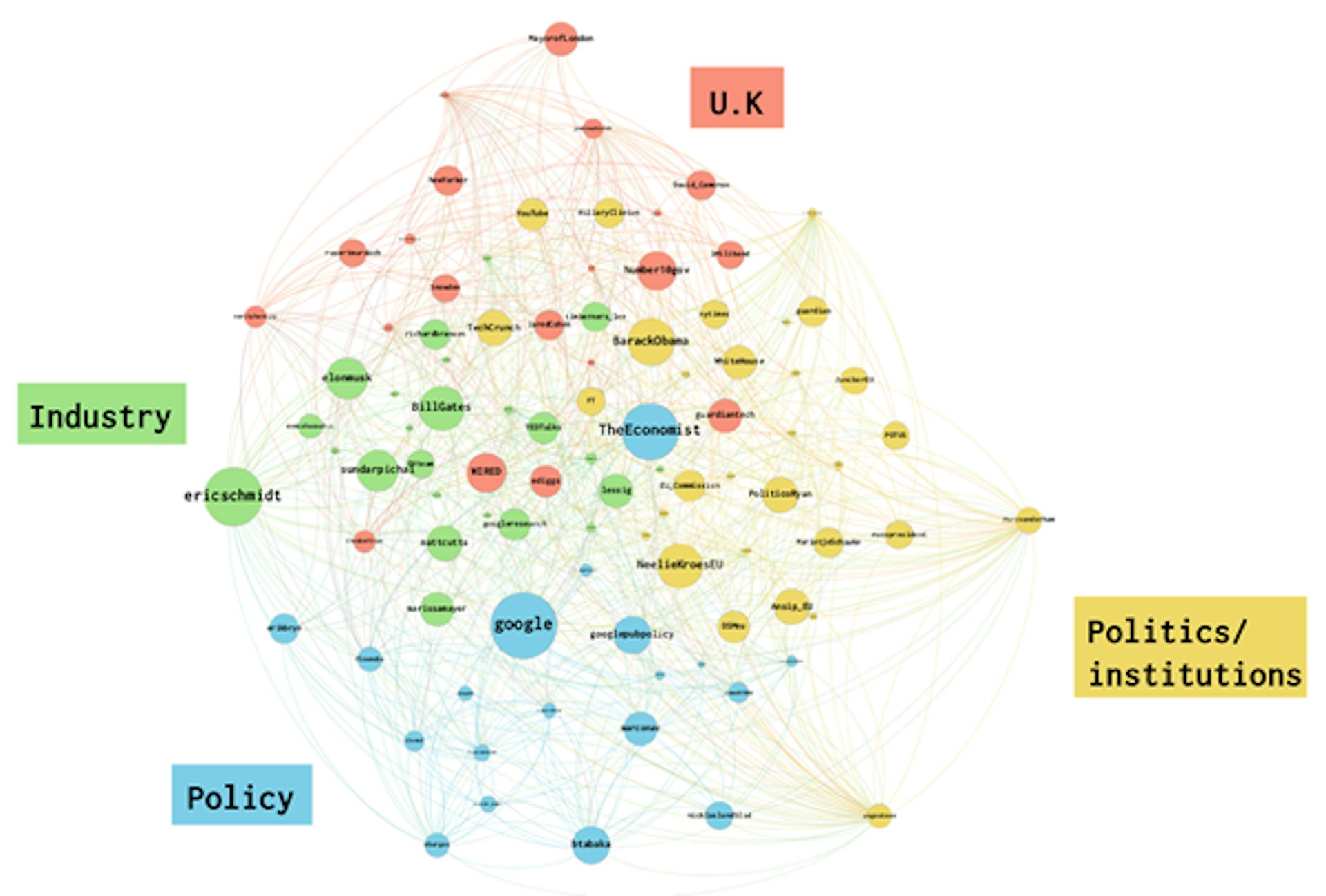
The Twitter accounts most followed by the people in our dataset. Visualisation and research by the working group during the University of Amsterdam Digital Methods workshop.
In order to understand who the most followed accounts that our dataset were following on Twitter we ran the data we had gathered on who was following who through the visualisation Gephy. The top three followed accounts are Eric Schmidt, Executive Chairman of Alphabet, The Economist and Google's Twitter account. We were able to identify the areas that those on our list were most interested in including: people and organisational accounts from the industry (green bubbles); individuals and institutions working in policy (red bubbles); EU and international institutions (yellow bubbles); and lastly UK related news, people and institutions (blue bubbles).
Who listens to them?
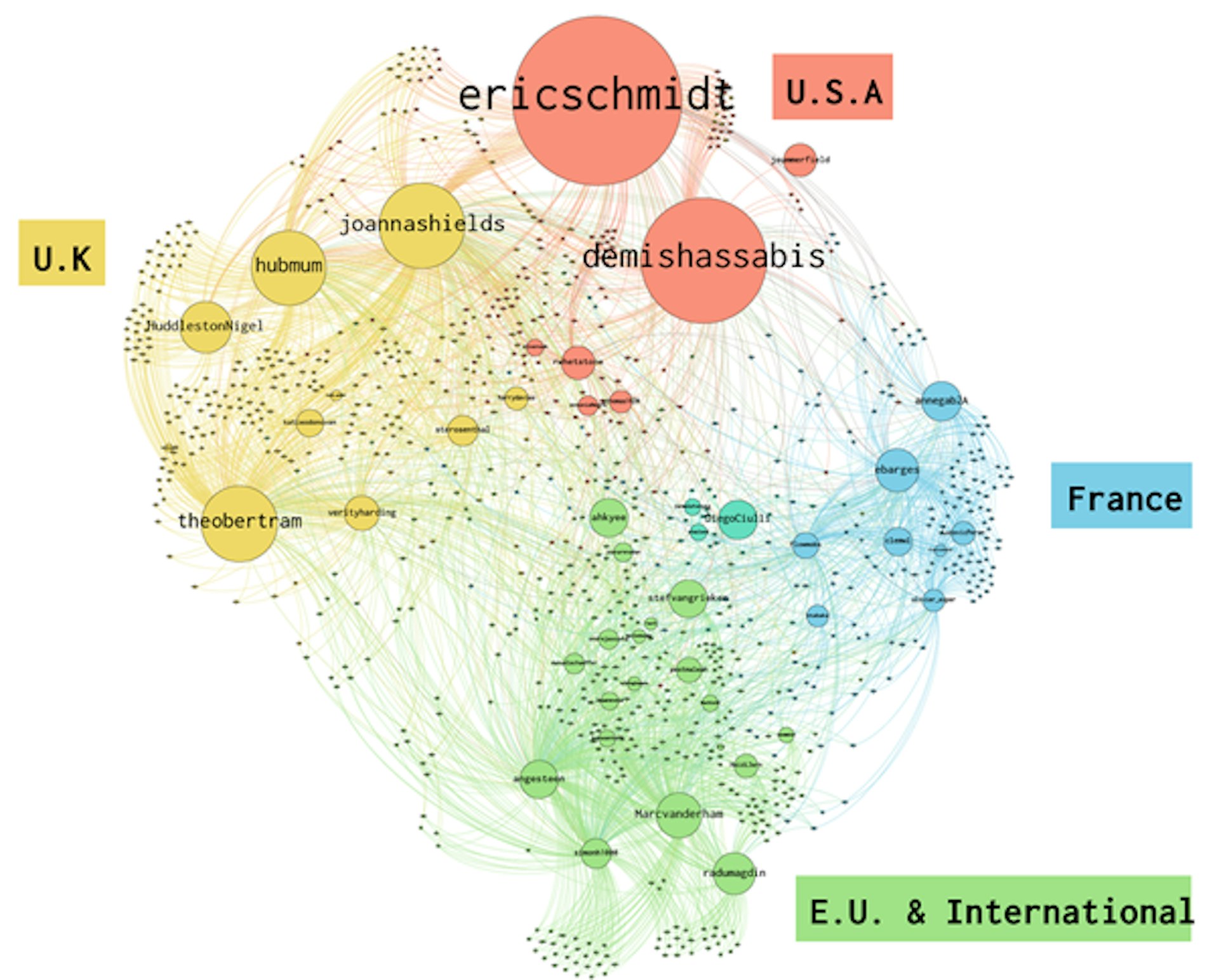
Eric Schmidt, Executive Chairman of Alphabet, is followed by the most people on our list followed by Demis Hassabis and Joanna Shields. This came as no surprise to us as they are some of the most high profile Googlers on our list.
Some of the people in the dataset either had no online presence on Twitter and LinkedIn or had selected that their profiles be private so that they could not be publicly accessed. As we gathered data online there is an online bias based on the assumption that everyone is online and we do not capture the “others” that are off the grid.
Even if a profile is public it is still very limited as to what you can scrape. It is in this respect that Facebook is not possible to scrape automatically, however, depending on their privacy settings, it's possible to manually investigate certain individuals.
Networks of influence
Our question throughout this week was how Google's influence on governments manifests itself online and to what extent can these online connections be taken to infer a connection to real world ties. We looked at social networking sites to attempt to identify metrics that could be used to determine signs on the online world of an offline relationship.
The group employed multiple methods to identify connections rather than adopting a one-size fits all technique. Due to our small dataset we limited the scope of our analysis which made employing these techniques more manageable however we found there were a number of limitations and restraints.
We found that those with real power and influence are difficult to track online and gather their information as their online profiles are more limited than those more transient members of Google and government officials. To find information on these individuals, we found media archives were more useful to dig through to find media mentions that discuss their skills, interests and influence than searching on social networking platforms.
This short investigation focused on the methods of information gathering as much as the potential results of the analysis. Similarly to the research project Investigating Metadata, undertaken by the data investigation group Share Lab, the subject matter was not the most important element, rather the analysis they deployed that could then be replicated on a number of topics and datasets.
The focus of this investigation was to look at what information could be found online that could expand or tell a different narrative than the data we already had access to. We are yet to discuss the ethics of using LinkedIn as a data source, a networking site that is considered private for those who use the site for what it was intended for, when in reality, the website and data contained within is public for all that want to look for it.
To read more about the ethical questions of using LinkedIn read our interview with M.C. McGrath, who launched IC Watch last year, a website that features thousands of LinkedIn profiles from the intelligence community.
Credits
With thanks to Ana Pop Stefanija, Benjamin Hervit, Christo, Fieke Jansen, Huda Alsahi, Jelly Luise Schuhmacher, Lorenzo Piazzoli, Matteo Azzi, Michele Invernizzi, Nick Forrester, Prem Borle, Simone Griesser and Valentina Dopona. Thanks to Digital Methods Summer School at the University of Amsterdam for facilitating and hosting the workshop.
Header image: George Osborne with Google’s chief executive, Eric Schmidt, at the Conservative Party conference in 2006, when Schmidt called Osborne ‘the voice of a new generation’. Photograph: Bloomberg via Getty Images. Via The Guardian
